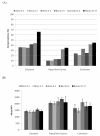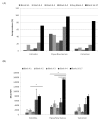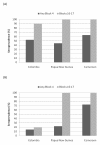Shift in epitope dominance of IgM and IgG responses to Plasmodium falciparum MSP1 block 4
- PMID: 20070906
- PMCID: PMC2837054
- DOI: 10.1186/1475-2875-9-14
Shift in epitope dominance of IgM and IgG responses to Plasmodium falciparum MSP1 block 4
Abstract
Background: Plasmodium falciparum merozoite surface protein-1 (MSP1) has been extensively studied as a blood-stage malaria vaccine candidate, with most work focused on the conserved 19 kDa and semi-conserved 42 kDa C-terminal regions (blocks 16-17) and the hypervariable N-terminal repeat region (block 2). However, recent genotyping studies suggest that additional regions of MSP1 may be under selective pressure, including a locus of intragenic recombination designated as block 4 within the 3' region of the gene.
Methods: The current study examined the antibody response to the two parental and two recombinant forms of block 4 and to blocks 16-17 (3D7) in study populations from Colombia, Papua New Guinea and Cameroon that differ in malaria transmission intensity and ethnic composition.
Results: IgM and IgG antibodies were detected against parental and recombinant MSP1 block 4 peptides in all three populations. Overall, 32-44% of the individuals produced IgM to one or more of the peptides, with most individuals having IgM antibodies reactive with both parental and recombinant forms. In contrast, IgG seropositivity to block 4 varied among populations (range 15-65%), with the majority of antibodies showing specificity for one or a pair of block 4 peptides. The IgG response to block 4 was significantly lower than that to blocks 16-17, indicating block 4 is subdominant. Antibodies to block 4 and blocks 16-17 displayed distinct IgG subclass biases, with block 4 responses biased toward IgG3 and blocks 16-17 toward IgG1. These patterns of responsiveness were consistently observed in the three study populations.
Conclusions: Production of antibodies specific for each parental and recombinant MSP1 block 4 allele in different populations exposed to P. falciparum is consistent with balancing selection of the MSP1 block 4 region by the immune response of individuals in areas of both low and high malaria transmission. MSP1 block 4 determinants may be important in isolate-specific immunity to P. falciparum.
Figures







Similar articles
-
Immunoglobulin G subclass-specific responses against Plasmodium falciparum merozoite antigens are associated with control of parasitemia and protection from symptomatic illness.Infect Immun. 2009 Mar;77(3):1165-74. doi: 10.1128/IAI.01129-08. Epub 2009 Jan 12. Infect Immun. 2009. PMID: 19139189 Free PMC article.
-
Serum antibodies from malaria-exposed people recognize conserved epitopes formed by the two epidermal growth factor motifs of MSP1(19), the carboxy-terminal fragment of the major merozoite surface protein of Plasmodium falciparum.Infect Immun. 1995 Feb;63(2):456-66. doi: 10.1128/iai.63.2.456-466.1995. Infect Immun. 1995. PMID: 7822010 Free PMC article.
-
Naturally Acquired Antibody Responses to Plasmodium vivax and Plasmodium falciparum Merozoite Surface Protein 1 (MSP1) C-Terminal 19 kDa Domains in an Area of Unstable Malaria Transmission in Southeast Asia.PLoS One. 2016 Mar 21;11(3):e0151900. doi: 10.1371/journal.pone.0151900. eCollection 2016. PLoS One. 2016. PMID: 26999435 Free PMC article.
-
Naturally Acquired Humoral Immunity Against Plasmodium falciparum Malaria.Front Immunol. 2020 Oct 29;11:594653. doi: 10.3389/fimmu.2020.594653. eCollection 2020. Front Immunol. 2020. PMID: 33193447 Free PMC article. Review.
-
Immunoglobulin M: Restrainer of Inflammation and Mediator of Immune Evasion by Plasmodium falciparum Malaria.Trends Parasitol. 2016 Feb;32(2):108-119. doi: 10.1016/j.pt.2015.09.007. Epub 2015 Nov 18. Trends Parasitol. 2016. PMID: 26597020 Review.
Cited by
-
Standardization and validation of a cytometric bead assay to assess antibodies to multiple Plasmodium falciparum recombinant antigens.Malar J. 2012 Dec 21;11:427. doi: 10.1186/1475-2875-11-427. Malar J. 2012. PMID: 23259607 Free PMC article.
References
-
- Tanabe K, Sakihama N, Walliker D, Babiker H, Abdel-Muhsin AM, Bakote'e B, Ohmae H, Arisue N, Horii T, Rooth I, Färnert A, Björkman A, Ranford-Cartwright L. Allelic dimorphism-associated restriction of recombination in Plasmodium falciparum msp1. Gene. 2007;397:153–160. doi: 10.1016/j.gene.2007.04.033. - DOI - PubMed
-
- Terrientes ZI, Vergara J, Kramer K, Herrera S, Chang SP. Restricted genetic diversity of Plasmodium falciparum major merozoite surface protein 1 in isolates from Colombia. Am J Trop Med Hyg. 2005;73:S55–61. - PubMed
Publication types
MeSH terms
Substances
Grants and funding
LinkOut - more resources
Full Text Sources
Molecular Biology Databases
Research Materials

